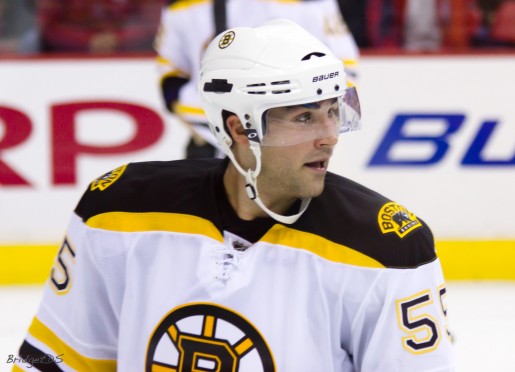By Bob Mand, Boston Bruins Senior Correspondent
Despite the Boston Bruins current status as one of the best teams in the Eastern Conference, a virtual lock for the postseason and arguably one of the favorites to win the Stanley Cup come June; they’re not without some major questions. Foremost among these is whether the defending champs need to make significant moves by the trade deadline.
The unbelievable run the Boston Bruins went on from November through the beginning of January was almost unprecedented (23-3-1). The entire squad appeared to be on fire for parts of the streak and saw outstanding performances from up and down the lineup.
Despite their two-month dominance and continued presence near the top of the conference and league standings, their recent dry spell (7-6-1 in their last fourteen games – the horror) has fans and analysts alike questioning this team’s capabilities going forward.
Truthfully, this sort of correction was to be expected. The B’s were riding through the end of 2011 with some unsustainably high numbers including ungodly save and shooting percentages. Were they really, really good? Of course – but Lady Luck certainly wasn’t failing them.
Including their disappointing loss to the Canucks on January 7, the Bruins have put the puck on net 474 times – almost 34 a night and around a shot per game higher than their season average. However, while they still sport an impressive 10.4% shooting rate this season (second in the NHL to Toronto), over the past month their forty total goals have them at a much more ‘earthly’ 8.4%.
Additionally, the Bruins’ defense hasn’t exactly ‘slipped’ much since the Vancouver match – they’ve allowed just over a half a shot more than their season averages to date (31.9 vs. a season per game average of 31.3). However, their overall team save percentage has taken a hit dropping from .939 to .931 in that span thanks to a fairly pedestrian .911 Sv% during this span. In fact, over a third of the Bruins goals allowed this season have come during their recent fourteen-game stretch.
Of course, numbers aren’t everything. Their forward corps is incredibly deep and talented. If health isn’t a factor – the only potential hole needing filled is third-line left-winger. Benoit Pouliot has done a solid job even if the production hasn’t been there: 8-9-17 in 46 games … but if the Bruins want some additional scoring (to add to what’s been the League’s best offense in 2011-12) that’s the spot they’ll likely look to upgrade.
The B’s thirteenth forward duties have been split between rookies Jordan Caron and Zach Hamill. Caron is bigger, more physical and can fill a checking-line role while Hamill is older and more experienced. Neither has consistently impressed this season and it’s doubtful the Bruins would be confident with either as a primary forward backup going into the spring.
However, with the uncertainty resulting from Nathan Horton’s concussion symptoms – Chiarelli might need to acquire someone with scoring potential to potentially fill in as a top-six winger (though the B’s own Rich Peverley has been solid in doing so of late). If Horton remains out much longer – or fails to produce when he returns – the B’s GM might be pressured to add a significant piece up front.
The blueliners are a bit trickier. It’s hard to quantify their aptitudes beyond strict production unless you get into shot differential statistics like Fenwick and Corsi and even then, some will argue that the “eyeball test” tells a different story. For the Bruins the only real certainty is Zdeno Chara, whose aptitudes as a super-plus defender and solid producer are without question.
After Chara, however, things get dicier. Going strictly by time-on-ice numbers, Dennis Seidenberg is the B’s number two, Johnny Boychuk the three, while Andrew Ference and Joe Corvo get about 18:30 a night and sophomore Adam McQuaid slots in at the six with Steven Kampfer slots in as the B’s seventh option.
Seidenberg isn’t a cut-and-dry number two in many eyes and some argue Boychuk’s frequent pairing with Chara hides many of his more egregious faults. Corvo takes the brunt of the criticism because he’s put up some tepid numbers offensively for an attack-minded blueliner and his defensive play leaves much to be desired.
Still, by their time-on-ice numbers in crucial situations, it’s easy to see how Coach Claude Julien trusts Boychuk and Seidenberg. It’s unlikely that they’ll be dealt (Boychuk slightly more possibly because of his upcoming UFA status) though an ‘upgrade’ bumping them down a peg isn’t out of the question. Corvo is on the hot seat and if the B’s decide to make a play for a more rounded offensive d-man, he could be out the door.
In recent weeks the B’s have been struggling against aggressive two-man forechecks. Without a plus puck-mover on their back end (outside of Kampfer, who’s only seen spot duty) they’ve been even more susceptible. With that in mind, GM Peter Chiarelli may consider adding one before the deadline – representing the position where the defending champs are most likely to make a splash.
Ideally, before the deadline prices get extortionate, the Bruins would pick up a strong veteran presence on the blue line to shore up the number seven spot with Kampfer yet to see action in the postseason and similarly grab a depth forward to see time as their thirteenth (and perhaps challenge Pouliot). It is their only certain area of need – depth beyond the starters – and given Chiarelli’s history, it’s fair to assume it will be addressed in the next month.
Barring additional injury, the Bruins won’t need to make any significant moves to be a contender in the upcoming postseason. Their outstanding two-month run proved that if they’re clicking, they can be a sublimely dominant squad. If they shake off a bit of the rust even without a move they’ll be well positioned as a high-seeded favorite come April.
Still, their recent difficulties have proven that they’re not bullet-proof and Chiarelli would be wise to consider options to augment one of the League’s best rosters via deals.

